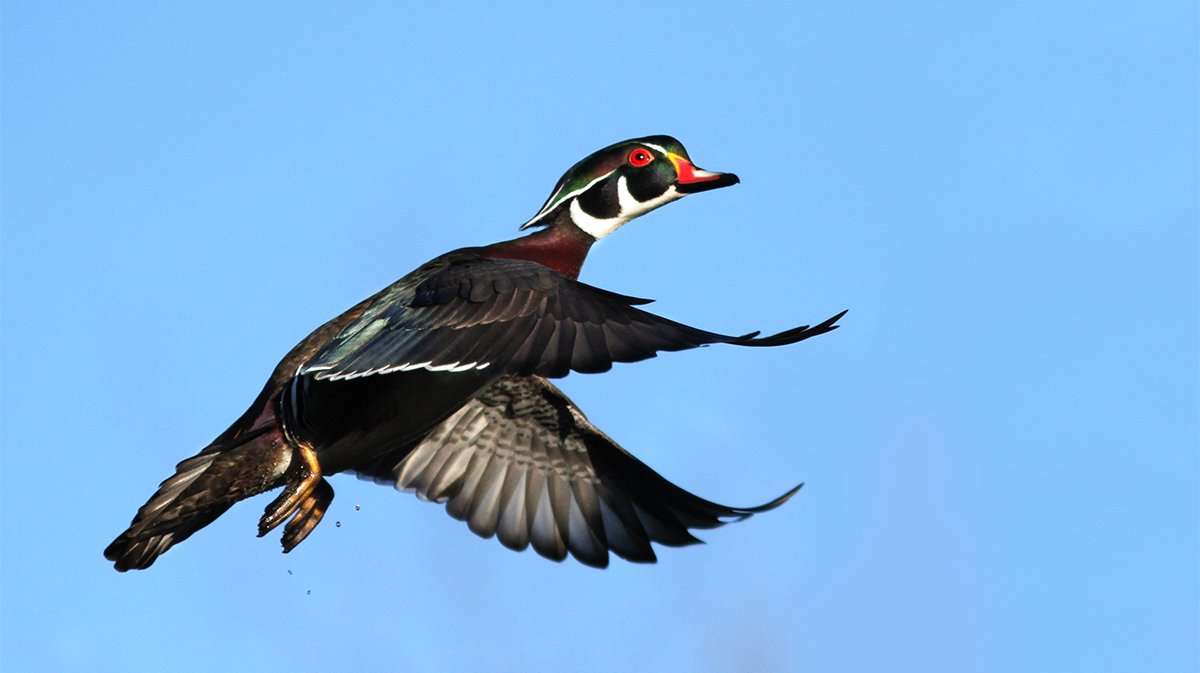Abundant Mallards, Bluewings and Wood Ducks are Keeping Hunters Happy
Date: Oct. 12
Location: Flyway-wide, trending toward the northern states
Major Weather Trends
A cool late summer gave way to unseasonably warm, dry weather during September and much of October. A few cool nights and north winds gave hunters hope for better conditions, but balmy days continue to dominate.
Water Conditions
Northern portions of the flyway that had been inundated with spring and early-summer rains are beginning to dry out. Many seasonal wetlands and areas of sheet water have disappeared, and water levels in major systems are receding.
Jeremy Dersham, owner of Ridge and River Running Outfitters in southern Wisconsin, said the dry spell has necessitated a change in tactics.
Water levels are low, making outboards difficult, he said. Mud motors have been able to get back to few locations, but plan on walking more to find secluded waters.
Tony Vandemore, owner of Habitat Flats in Sumner, Missouri, said his area has been extremely dry, making it difficult to pump water into hunting locations.
I think it should be another strong fall in Missouri, but a little rain would certainly help the pumping efforts and stop more of the early migrators, he said.
Habitat Conditions
Generally, nesting habitat was strong in production states. The cool, wet spring and early summer hampered the development of some grain crops, but dry weather in late summer and early fall allowed farmers to harvest small grains, begin harvesting beans and, in many areas, chop corn. Natural food sources appeared to be excellent. Acorns from white oaks are incredibly abundant in many areas, which will benefit mallards, wood ducks and other birds.

Species and Numbers
Northern states had excellent numbers of mallards, wood ducks, blue-winged teal and Canada geese, and despite the summer-like weather, most hunters reported good early-season action.
Realtree.com contributor Tom Carpenter hunted Minnesota's opening weekend along with five other hunters, and the group limited out both days, mostly on blue-winged teal.
Dersham said action on woodies and other ducks has been consistently good in southern Wisconsin.
We've been able to kill three-man limits of wood ducks pretty regularly, holding out for the majority of adult drakes, he said. We're killing both blue- and green-winged teal in small waters and back bays off the Wisconsin River, but numbers haven't been great. We are also seeing decent numbers of big ducks and mallards, but you have to search for them. We've had a good push of new geese arrive. We're seeing both geese and mallards, with a few blacks and pintails mixed in, hitting chopped and picked corn fields close to roost areas off of rivers and small ponds. We've also seen good numbers of birds hit freshly picked bean fields.
Realtree.com contributor Joe Shead said waterfowl numbers in northern Wisconsin looked good in early September, but hunting action has slowed somewhat.
Opening weekend, I thought there were good numbers of mallards in northwestern Wisconsin, he said. There were teal and woodies, too, but mallards were most notable.
Shead reported seeing some redheads and ring-necked ducks (common early migrants in northern Wisconsin) along with a few bluebills, mallards and bluewings during a recent hunt. Also, he's witnessed some snow and blue geese filtering into the area, usually mixed with honkers.
Vandemore said Missouri's early teal season was extremely poor.
We had a decent batch the week before the season, and they left two days before we opened, he said.
Personal Hunting Report
Early-season goose hunting was excellent, as many areas had more local honkers than I'd ever seen. Birds responded well to setups in harvested oat and wheat fields, plus freshly cut alfalfa (hay) fields. A secluded loafing area produced a great opening day water-hunt.
I enjoyed good hunts during Wisconsin's Northern Zone and Southern Zone duck openers, taking mostly wood ducks but adding some bluewings and a few mallards. Wood ducks have dominated the bag since then.
Opening-week hunting pressure was extremely heavy in some areas, but subsequent warm weather seems to have discouraged many folks from heading afield.
Boat Ramp Chatter
Shead said a fanatical waterfowling friend has experienced extremely poor success in northern Wisconsin and wondered if summer hail storms might have affected local duck numbers. Hunters elsewhere in the state are chuckling at the irony of August cool fronts that seemingly moved many bluewings south before the early teal season. Still, abundant wood ducks and other birds have minimized complaints.
Upcoming Patterns/Hotspots
Goose hunting will only improve when the first cold fronts of October finally arrive. Corn is extremely abundant in many areas this year, and when farmers cut those fields, honkers will follow. Interestingly, despite a phenomenal acorn crop, mallards and wood ducks seem to be hitting fields extremely frequently this fall.
Mallard and diver nuts are anxiously awaiting migratory flights, but as always, success will hinge greatly on weather patterns.
Click here for more Realtree waterfowl hunting content. And check us out on Facebook.







